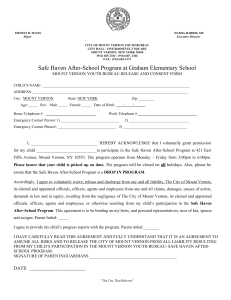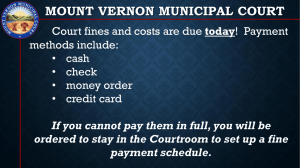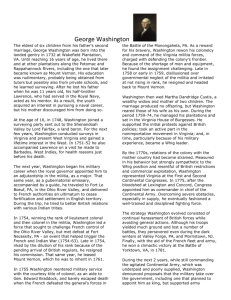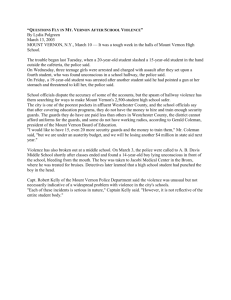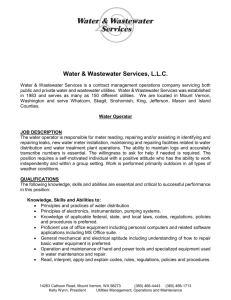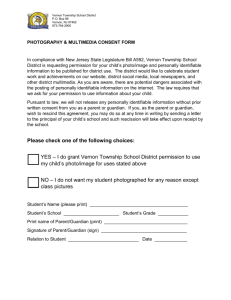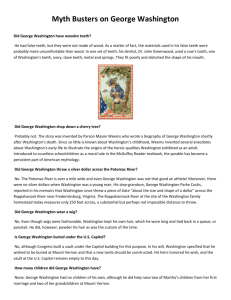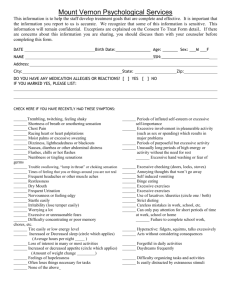WalkingTour - City of Mount Vernon
advertisement
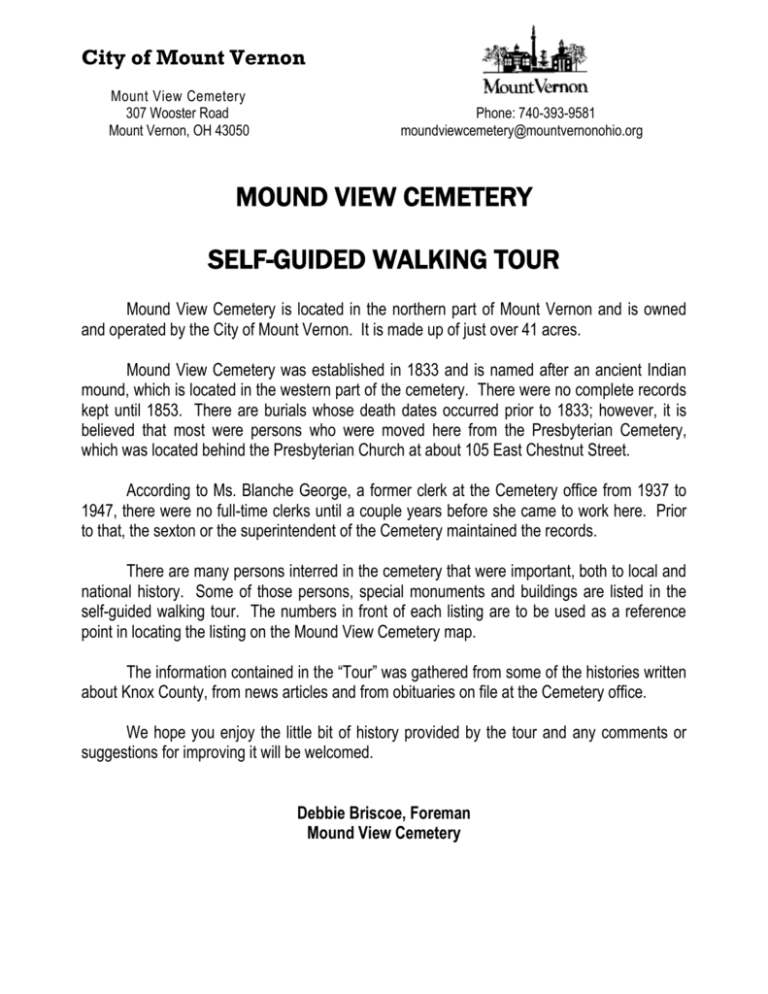
City of Mount Vernon Mount View Cemetery 307 Wooster Road Mount Vernon, OH 43050 Phone: 740-393-9581 moundviewcemetery@mountvernonohio.org MOUND VIEW CEMETERY SELF-GUIDED WALKING TOUR Mound View Cemetery is located in the northern part of Mount Vernon and is owned and operated by the City of Mount Vernon. It is made up of just over 41 acres. Mound View Cemetery was established in 1833 and is named after an ancient Indian mound, which is located in the western part of the cemetery. There were no complete records kept until 1853. There are burials whose death dates occurred prior to 1833; however, it is believed that most were persons who were moved here from the Presbyterian Cemetery, which was located behind the Presbyterian Church at about 105 East Chestnut Street. According to Ms. Blanche George, a former clerk at the Cemetery office from 1937 to 1947, there were no full-time clerks until a couple years before she came to work here. Prior to that, the sexton or the superintendent of the Cemetery maintained the records. There are many persons interred in the cemetery that were important, both to local and national history. Some of those persons, special monuments and buildings are listed in the self-guided walking tour. The numbers in front of each listing are to be used as a reference point in locating the listing on the Mound View Cemetery map. The information contained in the “Tour” was gathered from some of the histories written about Knox County, from news articles and from obituaries on file at the Cemetery office. We hope you enjoy the little bit of history provided by the tour and any comments or suggestions for improving it will be welcomed. Debbie Briscoe, Foreman Mound View Cemetery 1. CHARLES B. KEIGLEY--(1885-1972) (Lot 38, Section E, Gr. 3) Mr. Keigley served 2 terms on City Council and was elected Mayor in 1921 during the time of prohibition and when women were granted the right to vote. He served 2 terms as Mayor. During his 4 years in office, a flagpole was erected on the square, the private Mausoleum was built at Mound View Cemetery and several of the City streets were paved. 2. THE WILD MEN OF BORNEO-HIRAM DAVIS (1825-1905), BARNEY DAVIS (1827-1912) (Lot 52, Section H, Gr. 1 and 2) Hiram and Barney Davis were dwarfs who toured the country with the Barnum and Bailey Circus. They were billed as the twin sons of the Emperor of Borneo, the only “Wild Men” in captivity. 3. SOLDIERS’ MONUMENT (Soldiers’ Reserve) This monument was presented to the Cemetery by the Joe Hooker Post #21, about 1884, in exchange for a section of the Cemetery, for the burial of veterans. 4. THE NEAL FAMILY MAUSOLEUM--GEORGE D. NEAL--(1844-1937)| (Section A) Mr. Neal was a prominent carriage manufacturer of Mount Vernon. 5. CHAPEL (Section A) The Chapel was built about 1887, its construction overseen by O.W. Hubbell. It has a holding vault in the rear of the building, which was used to store caskets when immediate burial had to be delayed. It has recently had some muchneeded repairs made, with additional renovations projected in the future. It has been the target of vandalism over the years. 6. LADY MONUMENT (Lot 165, Section D) This life-size monument marks the burial places of James (18651950), Mina (1872-1930) and Ruth J. (1898-1912) Stinemetz. It has been damaged over the years by vandals, but is still a very beautiful monument. 7. RANSOM VAULT (Section C) The Ransom Family were prominent bricklayers in Mount Vernon who built this private family mausoleum. Mr. Robert Ransom said he believed his father, Harry, and his grandfather, Oscar, did the actual construction work. There are 16 catacombs, of which 9 have been used. 8. TREE MONUMENT (Lot 27, Section B, Gr. 3 & 4) This unusual monument marks the burial place of Henry L. (1834-1893) and Jeanette (1848-1926) Bucher. Page 2 of 11 9. JOHN EWALT--(1760-1828) (Lot 66, Section 5, Gr. 3) Mr. Ewalt was a Private in the Militia during the Revolutionary War. He and his wife moved to Knox County in 1815 and lived here until his death in 1828. He is one of six known Revolutionary War Veterans buried here 10. THOMAS DAVIS--(1753-1840) (Lot 68, Section 4, Gr. 6) After enlisting in 1781, Mr. Davis served in the Revolutionary War for 2 years. He is one of six known Revolutionary War Veterans buried here. 11. SEN. JESSE BURGESS THOMAS--(1776-1853) (Lot 66, Section 4, Gr. 5) Sen. Thomas studied law in Kentucky, was a member of the territorial legislature, speaker of said body for more than 3 years, delegate in Congress, United States Judge in the Illinois territory, delegate to a constitutional convention, and its presiding officer and a United States senator from Illinois for 10 years. Sen. Thomas introduced the once famous, “Missouri Compromise” to the United States Senate. He and his wife moved to Mount Vernon in 1828. In 1829, Sen. Thomas took an active part in the organization of St. Paul Episcopal Church in Mount Vernon. He made large additions to Mount Vernon, laying out lots in the eastern and northern parts of the City. 12. DR. JONATHAN NASH BURR--(1800-1889) (Lot 65, Section 4, Gr. 5) Dr. Burr was one of the early doctors of Mount Vernon. He was one of the members who established St. Paul’s Protestant Episcopal Church. 13. GILMAN BRYANT--(7-27-1784/6-10-1859) (Lot 54, Section 1, Gr. 6) Mr. Bryant was one of the early pioneers of Knox County. His early trading was mostly with the Indians. He was the first merchant, the first postmaster, the first recorder of deeds for Knox County, built the first frame house and the first brick house in Mount Vernon and married the daughter of the first minister of Gospel to settle in Knox County. His father was a cousin of William Cullen Bryant, the poet. 14. DR. JOHN WADHAMS RUSSELL--(1-28-1804/3-22-1887) (Lot 31, Section 1, Gr. 1) Dr. Russell graduated from Jefferson Medical College in 1827. In the fall of 1828, he settled in Mount Vernon where he practiced medicine and surgery. During the Civil War, he was one of the examining surgeons for admission of volunteer surgeons into the army. He was asked many times to accept chairs in medical colleges in Ohio, but remained in private practice. He was a past president of the Ohio State Medical Society. He was also an important influence for several local physicians who started their career under his tutelage. Page 3 of 11 15. WILLIAM C. COOPER--(12-18-1832/1902) (Lot 32, Section 1, Gr. 2) A prominent lawyer, Mr. Cooper was Knox County Prosecuting Attorney in 1858 and 1860. He served as Mayor in 1860 and 1862. In 1877, he was appointed Judge Advocate General of the State of Ohio. 16. JONATHAN MILLER--(1760/2-7-1849) (Lot 50, Section 1, Gr. 4) Mr. Miller was an Ensign under the command of Capt. Daniel Clapsaddle in the Flying Camp, Washington Co., Maryland during the Revolutionary War. He is one of six known Revolutionary War Veterans buried here. 17. JOHN KREPPS MILLER—(5-25-1819/8-11-1863) (Lot 49, Section 1, Gr. 2) Mr. Miller was a Representative from Ohio. He was a delegate to the Democratic National Convention in 1844 and was elected to the Thirtieth & Thirty-first Congresses. 18. WILLIAM ROBINSON SAPP—(3-4-1804/1-3-1875) (Lot 48, Section 1, Gr. 1) Mr. Sapp was a Representative from Ohio. Was erected as a Whig to the Thirty-third Congress and reelected as an Opposition Party candidate to the Thirty-fourth Congress; was an assessor of internal revenue for the thirteenth district from 1869-1872; and was collector of internal revenue from 1872 until 1875. 19. DANIEL DECATUR EMMETT—(1815-1904) (Lot 37, Section 1, Gr. 5) Mr. Emmett was known as the composer of the famous song, “Dixie”. He is generally regarded as the Father of the American Minstrel Show. 20. ISAAC YOUNG--(9-23-1730/10-18-1812) (Lot 2, Section 1, Gr. 1) Mr. Young was a Private in the Militia during the Revolutionary War. He is one of six known Revolutionary War veterans buried here. 21. JACOB BOOKER BROWN, ESQ.--(7-2-1802/9-1-1854) (Norton/Warden Reserve) Mr. Brown was the pioneer jeweler of Mount Vernon. He also served 2 terms as Mayor and had started his third just before his death. He opened his first establishment in Mount Vernon in 1826. 22. ROLLIN C. HURD--(9-12-1815/1874) (Norton/Warden Reserve) Mr. Hurd was a prominent lawyer and Judge of the Common Pleas Court. He served as the President of the Cleveland, Mount Vernon and Columbus Railroad, and was very instrumental in its completion. Page 4 of 11 23. FRANK HUNT HURD—(12-25-1840/7-10-1896) (Norton/Warden Reserve) Mr. Hurd was a Representative from Ohio. He graduated from Kenyon College in 1858; studied law & was admitted to the bar in 1861. He was Knox County Prosecuting Attorney in 1863; was a member of the State Senate in 1866; and was elected to the Forty-fourth, Forty-sixth, and Forty-eighth Congresses. 24. DANIEL S. NORTON--(1786/10-25-1859) (Norton/Warden Reserve) Mr. Norton set up the first carding machines west of the Allegheny Mountains. He was elected to the State Senate in 1825. He contributed liberally to the establishment of Kenyon College. 25. REV. ANTHONY BANNING--(5-13-1768/2-5-1844) (Norton/Warden Reserve) Rev. Banning served as Associate Judge from Knox County from 1827-1834. He also served as a minister all his life and built the Banning Chapel. 26 . HOSMER CURTIS--(7-29-1788/5-14-1874) (Curtis Lot, Section 3) Mr. Curtis was a prominent lawyer of Mount Vernon. He came to Mount Vernon in 1815, and held many important offices (both local and state) during his lifetime here. He was regarded as the “father of the bar”. 27. HENRY B. CURTIS--(11-28-1799/11-5-1885) (Curtis Lot, Section 3) Mr. Curtis was the brother of Hosmer and also a notable lawyer. His home was the Curtis Mansion, known as Round Hill. He was instrumental in the selection of the site for Kenyon College. He also built the Curtis House Hotel. 28. CURTIS UNDERGROUND VAULT (Section 3) This is a private family vault that is located entirely underground, where several family members are entombed in crypts. Rumor says that the underground vault was used to hide runaway slaves and that there were tunnels connecting it to the Curtis Mansion at Round Hill. There has never been any evidence of the tunnels found in the underground crypts. 29. ZARAH CURTIS--(5-2-1761/6-7-1849) (Lot 1, Section 3, Gr. 1) Mr. Curtis was a Revolutionary War Soldier, enlisting January 1, 1781. He served for 5 years until the end of the War. During his later years, he was an Elder and Minister. He was the father of Hosmer and Henry B. Curtis. He is one of 6 known Revolutionary War Veterans buried here. 30. RUFUS WARD--(1759/9-8-1834) (Lot 37, Section 3, Gr. 1) Mr. Ward enlisted in the Revolutionary War in 1776 at the age of 17. By trade, he was a farmer and cooper. He is one of six known Revolutionary War Veterans buried here. Page 5 of 11 31. FRED S. HAYES--(5-19-1899/2-11-1985) (Lot 59, Section 12, Gr. 4) Mr. Hayes was a sportswriter for the Mount Vernon News. He was one of the first persons to organize a teenage baseball league. He was a great fan of Mount Vernon High School and Ohio State University sports 32. DR. JANE PAYNE--(9-1-1825/1882) (Lot 33, Section 12, Gr. 6) Despite many physical infirmities, Ms. Payne became a physician, graduating valedictorian in the 10th class of the Women’s Medical College of Pennsylvania at Philadelphia in March 1861. She came back to Mount Vernon to practice, which was not easy because of the prejudices against female physicians. In spite of the many adversities, she continued her practice until 4 months before her death from cancer in 1882. 33. GRIEVING MOTHER MONUMENT (Lot 10, Section 13) This is an unusual monument marking the graves of Winfield March (1880-1894), Carl March (1878-1899), and Dana D. March (1886-1907). 34. FRANK LETTS BEAM--(11-14-1858/1938) (Lot 70, Section 13, Gr. 3) Mr. Beam began his business career as a clerk in a hardware store in Mount Vernon. In 1880, he engaged in the crockery and wallpaper business here, which he continued until 1901. In 1895, he became interested in the independent telephone business and organized and was involved in many of the early telephone companies of Ohio. He served as president/general manager of several of them. He was one of a group who organized the Mount Vernon Country Club and served as a member of the Board of Directors for many years. He was a former president of the Mount Vernon Chamber of Commerce and always took a great interest in that organization, as well as many other civic affairs. Mr. Beam also served on the Board of Education. 35. WILLIAM FLETCHER SAPP--(11-20-1824/11-22-1890) (Lot 75, Section 13, Gr. 3) Mr. Sapp was a Representative from Iowa. He was elected as Knox County prosecuting attorney in 1854 & 1856; was appointed Adjutant General of Nebraska Territory in 1861; was a member of the Territorial Legislative council; was a member of the Iowa State House of Representatives in 1864; was United States District Attorney for Iowa 1869-1873; was elected as a Republican to the Forty-fifth and Forty-sixth Congresses. 36. WILLIAM BURR BROWN--(1832-1918) (Lot 66, Section 13, Gr. 3) Mr. Brown served as Mayor of Mount Vernon for 2 terms. He was the son of J.B. Brown and was a jeweler like his father. Page 6 of 11 37. DR. JOSEPH C. GORDON--(3-6-1841/10-6-1895) (Lot 9, Southwest Addition, Gr. 1) Dr. Gordon joined the Ohio Volunteer Infantry in 1861, and participated in many battles of the Civil War. He was discharged in the fall of 1864. He began studying medicine with Dr. John Russell in the spring of 1865. He graduated from the Jefferson Medical College of Philadelphia in 1868. He was a past president of the Knox County Medical Society. The Knox County Historical Society has an original diary kept by Dr. Gordon during his Civil War service. 38. JAMES H. DEBES--(4-21-1864/12-25-1967) (Lot 3, Section 15, Gr. 4) Mr. Debes was the “First Real Engineer” that the Cooper Company ever had. He helped his brother-in-law build Hiawatha Park, the famed entertainment center, once located on the site of the Knox County Fairgrounds. He was also one of the founders of the Mount Vernon Country Club. 39. CHARLES COOPER--(1-2-1811/2-7-1901) (Lot 8, Section 15, Gr. 3) Mr. Cooper was the senior member of the C and G Cooper Company. He started the business in 1834. 40. ROBERT C. KIRK--(2-26-1821/-1898) (Lot 27, Section 15, Gr. 7) Mr. Kirk was a member of the Ohio State Senate, served 1 term as Lieutenant Governor (1860-62), received an appointment to be Minister to the Argentine Republic (1862-66 & 1869-71), and was appointed Collector of Internal Revenue for the 13th District by President Grant. He at one time owned the home that is now Dowds-Snyder Funeral Home and also the home at 306 E. Gambier Street. 41. LECKY HARPER--(12-29-1815/6- -1895) (Lot 23, Section 15, Gr. 3) Mr. Harper was a local newspaper editor who was both famous and infamous. He was the “owner, editor, writer, typesetter, janitor, reporter and salesman” of the Mount Vernon Democratic Banner from 1853 to 1895. He learned the newspaper trade, studied law and was admitted to the bar. Mr. Harper wrote against power, the establishment, Wigs and big government. He gained national prominence for his editorials in support of child labor laws. He was elected to the State Senate in 1879. 42. WILLIAM PENN BOGARDUS--(1841-1920) (Lot 33, Morgan Addition, Gr. 3) Mr. Bogardus was a member of the Seventh Independent Cavalry, which served as Abraham Lincoln’s bodyguards. He also owned a hardware store, located on the square, ”Bogardus and Company”. Page 7 of 11 43. GENERAL GEORGE W. MORGAN--(9-20-1820/7-26-1893) (Lot 34-35, Morgan Addition, Gr. 6) General Morgan came to Mount Vernon in 1843. He had a very distinguished military career, serving in the Texas War of Independence, the Mexican War, and the Civil War. He served as Knox County Prosecutor, was the U.S. Consul at Marseilles, France, and was the American Minister to Portugal when the Civil War broke out. 44. BEATTY B. WILLIAMS--(8-22-1876/12-29-1969) (Lot 20, Section 19, Gr. 6) Mr. Williams was president and general manager of Cooper-Bessemer for many years. He was a founder of the Mount Vernon Community Trust in 1944. He helped establish the first YMCA in Mount Vernon in 1907-08. He was president of the National Council of the YMCA in 1935-36, was a member of the World committee and was a delegate to the YMCA World Conference in 1926. Mr. Williams was one of the founders of the Mount Vernon Country Club. 45. CHARLES FRANKLIN WEST—(1-12-1895/12-27-1955) (Lot 19, Section 19, Gr. 5) Mr. West was a Representative from Ohio. He served as vice consul at Naples, Italy in 1918 and 1919; was instructor of government at the College of Wooster (1920-1922) and at Harvard University (1922-1924; was professor of political science at Denison University (1914-1930); was elected as a Democrat to the Seventy-second and Seventy-third Congresses; served as special assistant to the governor of the Farm Credit Administration ; was appointed Under Secretary of the Interior (8-5-1935/5-10-1938; and was a delegate to the Democratic National Convention in 1936 46. MOUND The following information is courtesy of Mr. Guy VanNostrand. “This mound was probably constructed by the “Mound-builders” in this area known as the Adena Indians, who lived in this part of Ohio from about 1000 BC. to 200 AD This mound was opened in the Summer of 1845 by Aaron Loveridge, and one skeleton of an Indian was found in a sandstone tomb at the original ground level. On July 30, 1894, James W. Hall and another Mound View Cemetery sexton were digging a grave for Henry G. Cooper on the edge of the Mound. They dug into a grave that contained the remains of an Indian, and found the following artifacts: an iron tomahawk-pipe, a copper breastplate, a copper bracelet and a shell necklace. It was the custom of most Indian tribes to bury personal belongings with their dead, especially a chief or person of rank in a tribe. A Delaware Chief named Sac-A-Manc was killed near Mount Vernon around 1812, and it is possible that members of his tribe could have buried him in the Mound View mound.” The mound has been used in more modern times for the burial of the Cooper and Curtis families, to name a few. Page 8 of 11 47. COL. JOSEPH W. VANCE--(7-9-1809/4-8-1864) (Lot 175, Section 16, Gr. 1) Col. Vance moved to Mount Vernon in 1840. He was admitted to the bar in 1842 and rose rapidly in his profession and soon attained a high position as an advocate. He was elected Mayor of Mount Vernon in 1852. In August 1862, he was commissioned Colonel of the Ninety-sixth Ohio Volunteer infantry. He was in several battles before he fell, mortally wounded, in the battle of Sabine Cross roads on April 8, 1864. 48. HONORABLE COLUMBUS DELANO--(1809/10-23-1896) (Lot 42, Section 16, Gr. 4) Mr. Delano was Prosecuting Attorney of Knox County. He was a delegate to the National Convention, which nominated Abraham Lincoln for President. He was appointed Commissary General of Ohio, was elected to the House of Representatives, was a member of the 29th, 39th and 40th Congresses, was appointed Commissioner of Internal Revenue by President Grant, and received an appointment as Secretary of the Interior. The Mount Vernon Nazarene College Administration Building was his former home, “Lakehome”. 49. DR. RALPH W. SOCKMAN--(10-1-1889/8-29-1970) (Lot 4, Section 18, Gr. 4) Dr. Sockman was one of the nation’s foremost preachers and ministers. He had a long career as pastor, radio speaker and lecturer. He was the past Pastor of Emeritus of Christ Methodist Church of New York City for over 44 years. 50. REV. LAWRENCE WM. MULHANE--(2-21-1856/5-2-1925) (Calvary Circle) Rev. Mulhane served as pastor of the St. Vincent de Paul Church from 1885-1925. In 1886, he published a book on leprosy. He also wrote many other works. He erected the new school building in 1890. (This grave is located in Mount Calvary Cemetery, which is owned by the Catholic Church and is located on the northwest side of Mound View Cemetery.) 51. DICK SHUFF--(3-3-1930/10-14-1980) (Lot 80, Section W, Gr. 1) Mr. Shuff was considered one of the best football players ever to play for Mount Vernon High School. He was also a standout basketball player and a member of the track team. 52. CLARENCE W. “COONEY” CURRAN--(1909/12-21-1967) (Lot 65, Section V, Gr. 1) Mr. Curran was best known as the City’s No. 1 Baseball and Softball umpire. Mr. Curran aided Carl E. Robinson in organizing the City’s Little League and Babe Ruth Programs. 53. MAUSOLEUM (Section O) The mausoleum was erected in 1924 and contains 200 crypts. It is privately owned. Page 9 of 11 54. JOHN W. RUDIN SR.--(D. 10-16-1977) (Lot 1, Section U, Gr. 3) Mr. Rudin was one of the organizers of the Ohio Council of Retail Managers. He was the President of the Rudin Company, a department store located on Main Street. He also served as past president of the Rotary Club, the Mount Vernon Chamber of Commerce, the Mount Vernon Country Club, the YMCA board, and was one of the founders of the Mount Vernon Community Trust. Mr. Rudin started his merchandising and selling career at the age of 8, selling rabbits at the Central Market in Columbus. In 1918, he became a partner in the store then known as the A.A. Dowds Dry Goods Company. In 1940, Mr. Rudin purchased Dowds’ interest and was joined in business by his sons, John W. Jr., and Walter M. The firm became the Rudin Company a year later. 55. CARL E. ROBINSON--(5-6-1919/12-7-1981) (Lot 7, Section U, Gr. 1) Mr. Robinson organized the Babe Ruth and Little League Baseball in Mount Vernon and built Lamb Park. He also served on the Board of Big Brothers and Big Sisters when it was first organized. 56. MAURICE A. MITCHELL--(1895/3-22-1972) (Lot 110, Section U, Gr. 1) Mr. Mitchell was a noted high school athlete. He served as physical director and later assistant secretary of the Mount Vernon YMCA. He organized and served as scoutmaster of early Boy Scout troops in Mount Vernon. He also played with the Mounts, a noted semi-pro basketball team in Mount Vernon in the 1920’s. He organized the Retired Men’s Club and was the recipient of two citizenship awards. In 1967, he received the Exchange Club’s Golden Deeds Award and in 1971, the Jaycees’ Outstanding Citizens Award. 57. JAMES A. BEAM--(5-14-1908/3-13-1987) (Lot 15, Section P, Gr. 1) Mr. Beam was the retired owner of the Millstone Cabinet Shop. He was involved in many clubs and organizations during his lifetime: VP First Federal Savings and Loan, past President of the YMCA, charter member of Mount Vernon Kiwanis Club and past Lieutenant Governor of Kiwanis International, a member of Mount Zion Masonic Lodge in Mount Vernon and 32nd degree Mason, past VP of Region 4 of Boy Scouts of America, state and national Sons of the American Revolution, Mayflower Descendants, past commodore of Buckeye Lake Yacht Club, Kentucky Colonel, past President of Mount Vernon Homestead Club, Telephone Pioneers Assoc., American Legion, Early American Industrialist Assn., curator of the Old Tool Crib Museum. He was also listed in Who’s Who in Commerce and Industry and Who’s Who in the Midwest. Page 10 of 11 58. JOHN S. RINGWALT--(1838-1907) (Lot 4, Section G, Gr. 2) Mr. Ringwalt was a dry goods merchant. He opened the first store May 10, 1873 in partnership with Mr. Henry W. Jennings. The store was moved to the location on Main Street, just south of the square, in 1879. On January 1, 1880, Mr. Ringwalt bought out Mr. Jennings’ interest and the store became Ringwalt’s. The store remained in business on S. Main Street until the 1990’s. It was purchased by First Knox National Bank and was torn down, and an addition to the bank built in 1994. 59. EASTERN STAR SECTION This section is on the site of the former cemetery pond and is only for the burial of Eastern Star members. The “Broken Column” monument is the emblem of the uncertainty of life and that death is no respecter of persons. It stands for unshakable faith in eternal life through belief in the work of Christ. Page 11 of 11
